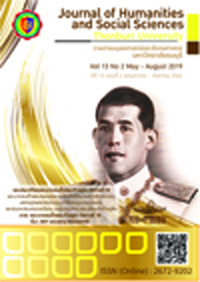THE MODEL OF DEVELOPING STUDENT LEADERSHIP FOR LOCAL DEVELOPMENT IN UPPER NORTH REGION RAJABHAT UNIVERSITIES
Keywords:
Leadership, Local Development, Student LeadershipAbstract
The purposes of this research were build leadership models and components for local development of student leaders among Upper Northern Region Rajabhat Universities. The research methods were divided into 3 periods. Period 1 was to study the components and characteristics of leadership for local development. Step 2 was to build the components of leadership development for local development of student leaders among Upper Northern Region Rajabhat Universities. The informants were divided into two main groups. Group 1 were student leaders academic year of 2016 from Upper Northern Region Rajaphat Universities as 21 sampling group consisted of 221. Group 2 were executives involved in student affairs and organized an In-depth Interview Guideline. Step 3 was about criticized patterns and components of leadership for local development of student leaders from Upper Northern Region Rajabhat Universities. The data was analyzed by content analysis and descriptive lectures. The research results showed The models and components of leadership for local development of student leaders among Upper Northern Region Rajabhat Universities were composed of followings 1) Placing a self-value; namely Self-Understanding, Congruence, Self-Development, and Stimulating Creativity. 2) Placing a value for being a role model; like; having a prototype, being accepted and being promoted and supported. 3) Placing a value for having participation; such as having a common goal, mutual recognition, and working as a team, and 4) Placing a value for community and society; particularly being a good citizen, having a conscious mind, serving as a volunteer, and recognizing the principles of living.
References
ประคัลภ์ ปัณฑพลังกูร. (2553). คุณสมบัติสำคัญของการเป็นผู้นำที่ดี. สืบค้นเมื่อ 8 ตุลาคม 2559, จาก https://prakal. wordpress.com/2010/06/25/5
มหาวิทยาลัยราชภัฎเขตภาคเหนือ. (2560). กำหนดการงานพิธีพระราชทานปริญญาบัตร พ.ศ. 2560 มหาวิทยาลัยราชภัฎเขตภาคเหนือ. (สูจิบัตร). เชียงใหม่: มหาวิทยาลัยราชภัฎเชียงใหม่.
รัตติกรณ์ จงวิศาล. (2556). ภาวะผู้นำ ทฤษฎี การวิจัย และแนวทางสู่การพัฒนา. กรุงเทพฯ : โรงพิมพ์แห่งจุฬาลงกรณ์มหาวิทยาลัย.
ลิขิตา เฉลิมพลโยธิน. (2560). ภาวะนำกับการพัฒนาองค์การโดยใช้ หลักพรหมวิหาร 4. วารสารวิชาการมหาวิทยาลัยธนบุรี. 11(26): 162-171.
สมเกียรติ สุทธินรากร. (2550). ภาวะผู้นำของนักศึกษามหาวิทยาลัยรังสิต. วิทยานิพนธ์ ศึกษาศาตรมหาบัณฑิต สาขาวิชาผู้นำทางสังคม ธุรกิจ และการเมือง มหาวิทยาลัยรังสิต.
สำนักงานคณะกรรมการพัฒนาการเศรษฐกิจและสังคมแห่งชาติ. (2550).แผนพัฒนาเศรษฐกิจและสังคมแห่งชาติ ฉบับที่ 11 พ.ศ. 2555-2559. กรุงเทพฯ: สำนักนายกรัฐมนตรี.
สำเนาว์ ขจรศิลป์. (2548). มิติใหม่ของกิจการนักศึกษา 2: การพัฒนานักศึกษา. กรุงเทพฯ: มหาวิทยาลัยเกษมบัณฑิต.
สุทธิชัย ปัญญโรจน์. (2554). คุณลักษณะผู้นำที่ดี. สืบค้นเมื่อ 9 สิงหาคม 2559, จาก http://oknation.nationtv.tv/blog/markandtony/ 2011/08/10/entry-1
สุเทพ พงศ์ศรีวัฒน์. (2558). รูปแบบภาวะผู้นำเพื่อการเปลี่ยนแปลงทางสังคม.สืบค้นเมื่อ 15 มกราคม 2558, http://suthep.crru.ac.th/
อนงค์นาถ ยุวพันธุ์. (2555).ภาวะผู้นำของนักศึกษาระดับปริญญาโทหลักสูตรบริหารธุรกิจมหาบัณฑิตสำหรับผู้บริหาร คณะบริหารธุรกิจ มหาวิทยาลัยเชียงใหม่. บริหารธุรกิจมหาบัณฑิต บัณฑิตวิทยาลัย มหาวิทยาลัยเชียงใหม่.
Dubrin, J.A. (1998). Leadership research finding, practice, and skills. [n.p.]: Houghton Mifflin.
Williamson, E. G. (1961). Student Personnel in College and Universities. New York: McGraw-Hill.
Translated Thai References
Chalermpolyothin, L. (2017). Leadership and Organization Development by Using Principles of Four Brahmavihara. Journal of Thonburi University. 11(26): 162-171. (in Thai)
Chareonwongsak, K. (2008). Leadership in Thai Children and Youth Bangkok: Bangkok Today. (in Thai)
Jongvisarn, R. (2013). LEADERSHIP: THEORIES, RESEARCH, AND APPROACH TO DEVELOPMENT. Bangkok: Chulalongkorn University Printing House. (in Thai)
Kajornsin, S. (2005).A new dimension of Student Affairs 2: Student Development. Bangkok: Kasem Bundit University.
Office of the National Economics and Social Development Board. (2007). The eleventh national economic and social development plan (2012-2016). Bangkok: The Office of Prime Minister's. (in Thai)
Panthawangkun, P. (2010). Key features of good leadership on October 8, 2016, from https://prakal.wordpress.com/ 2010/06/25/5 (in Thai)
Panyaroj, S. (2008). Retrieved August 9, 2013, from http://oknation.nationtv.tv/blog/markandtony/2011/08/10 /entry-1 (in Thai)
Pongsrivat, S. (2015). Social Change Model of Leadership. Retrieved January 15, 2015 from http://suthep.crru.ac.th/ (in Thai)
Suttinarakorn, S. (2007). Leadership of Rangsit University 's student. Thesis Master of Education Leadership in Society, Business and Politics Rangsit University. (in Thai)
Upper North Region Rajabhat University. (2017). Upper North Region Rajabhat University Graduation Ceremony Itinery for Academic Year 2017. Chiang Mai: Chiang Mai Rajabhat University. (in Thai)
Yuwaphan, A. (2012). Leadership of graduate students in executive MBA program, faculty of business administration, Chiang Mai University. Master of Business Administration The Graduate School Chiang Mai University. (in Thai)







